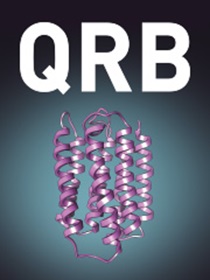“光系统II:光合作用的水分解酶和大气中氧气的来源”
IF 7.2
2区 生物学
Q1 BIOPHYSICS
引用次数: 54
摘要
大约30亿年前,一种酶的出现极大地改变了地球的化学成分,并引发了生物活动的空前爆发。这种酶利用太阳能为水分解的热力学和化学反应提供动力。在这样做的过程中,它为生物学提供了无限的还原性等价物,这些还原性等价物需要将二氧化碳转化为生命的有机分子,同时产生氧气,将我们星球的大气从厌氧状态转化为有氧状态。促进这一反应的酶被称为光系统II (PSII),因此是地球上几乎所有生命的基础。它是一种与色素结合的多亚基蛋白复合物,嵌入在植物、藻类和蓝藻类囊体膜的脂质环境中。今天,我们对这种关键而独特的酶的结构和功能有了详细的了解。人类达到这种知识水平的历程可以追溯到18世纪氧气本身的发现。从那时起,一系列的巨石发现构成了一个迷人的故事,延续了200多年。但直到最近几年,人们才提供了必要的细节,揭示了水氧化和O-O键形成的化学过程。特别是,分离的PSII酶的晶体结构已被报道,分辨率不断提高。因此,它的许多亚基和辅因子的组织和结构细节现在被很好地理解了。水裂解位点由4个Mn离子和1个Ca离子组成,由氨基酸侧链包围,其中7个为金属提供直接配体。金属簇是由三个Mn离子和一个Ca2+组成的立方结构,由氧键连接,第四个Mn离子附着在立方上。这种结构现在已经在非蛋白质环境中合成,这表明它是光合作用氧气进化复合体进化的完全无机前体。综上所述,催化位点的整体结构为建立光合作用生成双氧的机制方案提供了框架,同时为开发用于分解水和产生可再生太阳能燃料的人工光电化学系统的催化剂提供了蓝图和激励。本文章由计算机程序翻译,如有差异,请以英文原文为准。
‘Photosystem II: the water splitting enzyme of photosynthesis and the origin of oxygen in our atmosphere’
Abstract About 3 billion years ago an enzyme emerged which would dramatically change the chemical composition of our planet and set in motion an unprecedented explosion in biological activity. This enzyme used solar energy to power the thermodynamically and chemically demanding reaction of water splitting. In so doing it provided biology with an unlimited supply of reducing equivalents needed to convert carbon dioxide into the organic molecules of life while at the same time produced oxygen to transform our planetary atmosphere from an anaerobic to an aerobic state. The enzyme which facilitates this reaction and therefore underpins virtually all life on our planet is known as Photosystem II (PSII). It is a pigment-binding, multisubunit protein complex embedded in the lipid environment of the thylakoid membranes of plants, algae and cyanobacteria. Today we have detailed understanding of the structure and functioning of this key and unique enzyme. The journey to this level of knowledge can be traced back to the discovery of oxygen itself in the 18th-century. Since then there has been a sequence of mile stone discoveries which makes a fascinating story, stretching over 200 years. But it is the last few years that have provided the level of detail necessary to reveal the chemistry of water oxidation and O–O bond formation. In particular, the crystal structure of the isolated PSII enzyme has been reported with ever increasing improvement in resolution. Thus the organisational and structural details of its many subunits and cofactors are now well understood. The water splitting site was revealed as a cluster of four Mn ions and a Ca ion surrounded by amino-acid side chains, of which seven provide direct ligands to the metals. The metal cluster is organised as a cubane structure composed of three Mn ions and a Ca2+ linked by oxo-bonds with the fourth Mn ion attached to the cubane. This structure has now been synthesised in a non-protein environment suggesting that it is a totally inorganic precursor for the evolution of the photosynthetic oxygen-evolving complex. In summary, the overall structure of the catalytic site has given a framework on which to build a mechanistic scheme for photosynthetic dioxygen generation and at the same time provide a blue-print and incentive to develop catalysts for artificial photo-electrochemical systems to split water and generate renewable solar fuels.
求助全文
通过发布文献求助,成功后即可免费获取论文全文。
去求助
来源期刊

Quarterly Reviews of Biophysics
生物-生物物理
CiteScore
12.90
自引率
1.60%
发文量
16
期刊介绍:
Quarterly Reviews of Biophysics covers the field of experimental and computational biophysics. Experimental biophysics span across different physics-based measurements such as optical microscopy, super-resolution imaging, electron microscopy, X-ray and neutron diffraction, spectroscopy, calorimetry, thermodynamics and their integrated uses. Computational biophysics includes theory, simulations, bioinformatics and system analysis. These biophysical methodologies are used to discover the structure, function and physiology of biological systems in varying complexities from cells, organelles, membranes, protein-nucleic acid complexes, molecular machines to molecules. The majority of reviews published are invited from authors who have made significant contributions to the field, who give critical, readable and sometimes controversial accounts of recent progress and problems in their specialty. The journal has long-standing, worldwide reputation, demonstrated by its high ranking in the ISI Science Citation Index, as a forum for general and specialized communication between biophysicists working in different areas. Thematic issues are occasionally published.
 求助内容:
求助内容: 应助结果提醒方式:
应助结果提醒方式:


